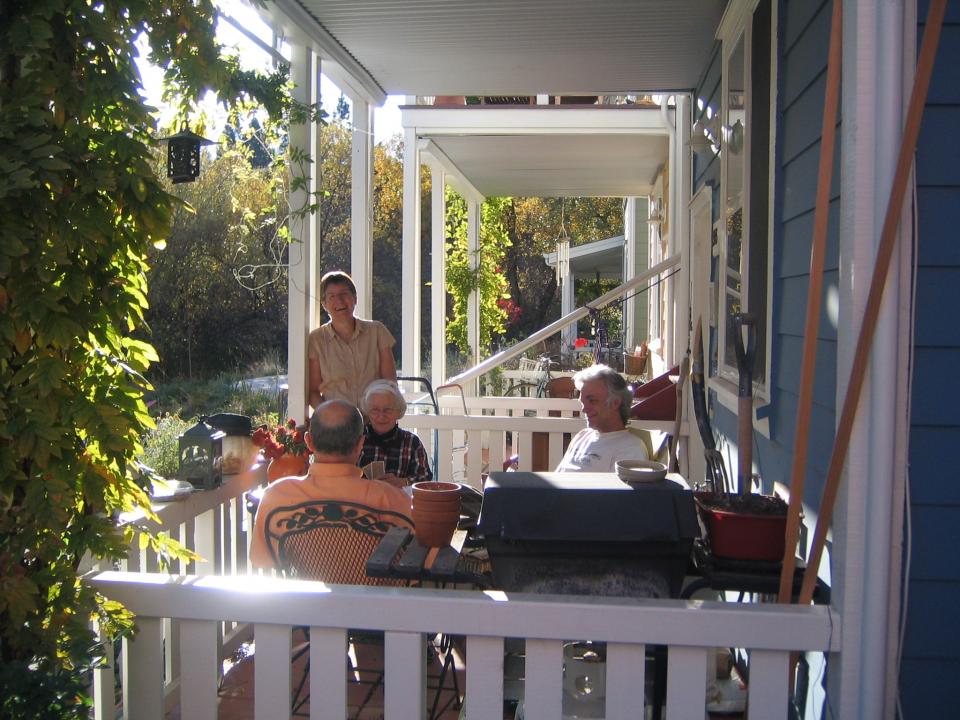By: Charles Durrett | Posted: August 10, 2016 | Updated: April 5, 2023
Nevada City Cohousing, Nevada City, CA.
Today we can text our sibling to find out what they are having for lunch in Paris, but we don’t know the name of our next-door neighbor, nor probably their birthday—unless we’ve looked him or her up on PoliceReport.com…because, you know, we should know who our neighbor is. It’s only prudent to be cautious.
Similarly, the increased need for police surveillance, emergency rooms, assisted care, after-school tutoring, out-of-the-neighborhood childcare, psychological therapy, and so many other institutionalized care activities that we have created reflect a waning of true community—for community can render these institutions much less necessary, if even necessary at all. There are so many pathologies in our society, and so many attempts to remedy them through institutions, graduate degrees, research, police, fire departments, social services, and every conceivable method other than personal engagement.
Accountability
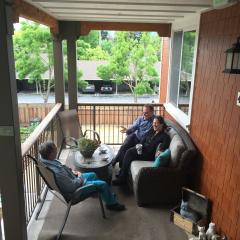
Many people are familiar with the idea that if the neighbor next door cares, or better yet, if an entire covey of neighbors that surround you really care about who lives next door — and who can act to support them—then the need for external behavior control mechanisms (from outside the community) diminishes immensely; likewise, the need for outside care or support, like psychological therapy, are less frequently outsourced from the community or not outsourced at all. Every one of these line items is immensely affected.
When folks feel accountable to their next-door neighbor, and don’t call the police just because someone parked in their driveway, then the costly police are less required. The number one call received by the fire department where I live in Nevada County, California, is a “pick-up and put-back” call (i.e. a senior has fallen in their own house and needs to be helped into bed). A huge portion of our county’s millions and millions of dollars of fire department budget goes toward providing services that a neighbor could do.
Services and accessibility
In 2014, the Paratransit shuttle for seniors (the big lumbering bus carrying usually one or two seniors, but capable of carrying 12) made 64,000 trips in western Nevada County for about 2,000 seniors to go to the doctor, to the pharmacy, to the store, or to visit a friend. Some people say that 30 trips per year per senior just to get them out of the house is far too few—others say far too many. Needless to say, there were zero pick-ups needed for the 20 seniors living in our cohousing community. Neighbors swing by to offer assistance if needed—“I’ll just pick up your medicine when I’m there”—and their best friend lives next door. Last year Americans drove over 7 billion miles to serve seniors at home, mostly Meals-on-Wheels and Nurses on the Go. (National Association for Home Care and Hospice) At Nevada City Cohousing, that didn’t happen at all.
We know that this is not sustainable when the funding necessary to provide these services shifts all the time. Kansas recently cut funding for senior support 30%. In 2015, Illinois, significantly cut funding for paratransit, leaving the seniors and the disabled isolated and without proper resources. (Chicago Tribune)
But what does this have to do with me?
What’s in community living for you? Why would you want to live in a community? What would you get out of it? Before I say more, allow me to tell you a couple of relevant stories.
Danger on the highway
Our local newspaper headlined this story not too long ago: “17-year-old boy passing an 80-year-old woman has a head-on collision with 76-year-old man. 76-year-old man perishes.” That reminded me that, in the new senior cohousing community just two miles from that “accident,” a 77-year-old resident recently told me at common dinner that he went from using four-to-five tanks of gas per month before moving into cohousing to less than one tank per month after moving into cohousing. That was no accident. That same evening, an 80-year-old resident said that after moving in she sold her auto altogether. Less driving equals less collision risk, and that is no accident. Both of them now meet with others at their convenience, have dinner with others at their choosing, and often have coffee with their neighbors in the mornings. Most mainstream senior living is no accident either, but more of a set-up: a set-up for either isolation or institutionalization.
Misconception
My late father once visited us in our community for 10 days. Before his visit he kept saying, “Yeah Chuck, I’m coming up. But now please explain to me one more time, why do you live in cohousing? You could have your own house.” I could only respond, “Well, we do live in cohousing and we still hope you visit. Oh, and by the way, we do have our own house, but in the context of a high-functioning neighborhood.” My father, like an unfortunately large amount of people in the U.S., coupled cohousing with other forms of co-living, where everyone lives under one roof and shares everything. When he finally visited, he was the last one out of the common house every single night. During those 10 days he cooked common dinner twice (without being asked)! Then, once back home, he lamented incessantly, “Why doesn’t anyone ever visit me?, and “I don’t know my neighbors.”
I asked him, “Dad, you had so much fun in Nevada City, Why don’t you just move into cohousing?” He retorted, “What would my friends think?”
His words remind me of Steven Covey’s sentiment, that one of the worst things that you can do to your own well-being and growth is to stereotype yourself: “Oh, that’s not me!” or “I couldn’t do that!”
For me, these stories were a rude awakening. In a very close and personal way, we ARE living according to nonsensical social restraints. And those are the same social restraints on which people base their “reasons” not to embark on senior cohousing. The number one of these “reasons”—or excuses—is the time it takes to put together a project. To which I say, nonsense! It doesn’t take long when there are homes available in a number of existing cohousing projects that people can just buy and move into immediately, and it’s OK to take advantage of the hard work of your predecessors and the profound community that they have already built there.
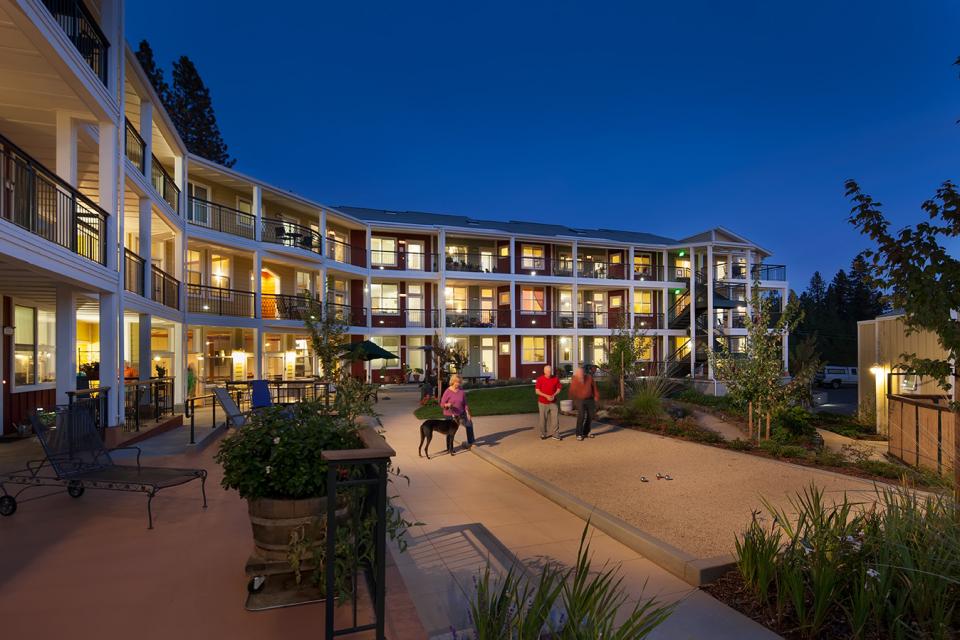
Life worth living
Community is what made my grandmother’s final years worth living. She lived in a small town of 325 people and was mostly bedridden in her waning 10 years. Fifteen locals looked after her; she didn’t spend a day in a nursing home. But she had that kind of small town caché. Cohousing is just that kind of reconceiving; the kind of reconceiving of community that we have been waiting for. It’s time to stop boxing ourselves into narrow parameters and face our realities. Many of us don’t have extended families nearby, we don’t have stay-at-home daughters to take care of us anymore, and we have few high-functioning small towns. According to Harper’s Magazine, 6,000 small towns have evaporated in Kansas since 1970, bought out by agribusiness. (Harper’s Magazine) But if we look up, we do have cohousing, and cohousing-inspired communities, within our reach.
We have all heard it said, “People have to pull themselves up by their bootstraps.” Have you ever actually seen anyone do that? What we all need is support, companionship, to feel needed—part of something—and we need to have fun! My concern is: are people doing the best they can to achieve these goals that really aren’t that far off? As a cohouser myself, I’m motivated to make the lives of my neighbors as easy as they make mine. We are each other’s stewards in the ebb and flow of our living landscape, which allows us to know, therefore care, and therefore support each other without it hindering my life or theirs. To learn how to grow old together is a natural part of life, more of a freeing experience than an encumbering one.
Isolation and lack of support
Let’s look at the issues at hand in a broader scale, a scale that lets us see the big picture. The topic of the hour is how senior services continue to be inadequate due to lack of funding, yet our population continues to get older. Then there are places like Nevada County (California), which support seniors with a majority of Community Services Block Grant funding. Not that there’s anything wrong with that, but it isn’t the most efficient way to ensure that seniors have a healthy life and doesn’t come close to covering the costs that senior services drum up. Furthermore, it takes away from services like drug counseling, childcare, suicide prevention, homeless shelters – you get the picture. Instead of trying to fix programs that can’t support the growing number of seniors (most of which are inadequate anyway), we need to talk with seniors about what they want. A supporting community allows seniors to be part of the solution, without consuming the lion’s share of the already thin resources.
At the other end of the spectrum (from community to disconnection), I find it disturbing when I read that the suicide rate of seniors is up to all-time records. According to the New York Times, suicide in citizens over 50 increased as much as 60 percent from 1999 to 2010. (New York Times) The social restraints, excuses, and myths that we let rule our lives produce an isolation that demonstrates that all of the current social norms are unfortunate at best. Perhaps suicide has come to be the ultimate individual statement: you really are all by yourself. Which reminds me of a young local homeless woman who told me once that her grandfather committed suicide while alone in his big house. It made me ponder: who was better off? At least she had a community in her homeless camp.
The time has come to work harder for community. So what’s holding us back? What’s the elephant in the room? Is it ignorance? Decreasingly so. You can find information and articles about cohousing published almost every single day. Is it shame? “I would be giving up my ranchette.” Are we talking about the same “ranchette” you work on until the waning moments, as the myth goes, and then they take you out boots first? Is it fear of commitment and obligation? If so, then you really don’t understand cohousing.
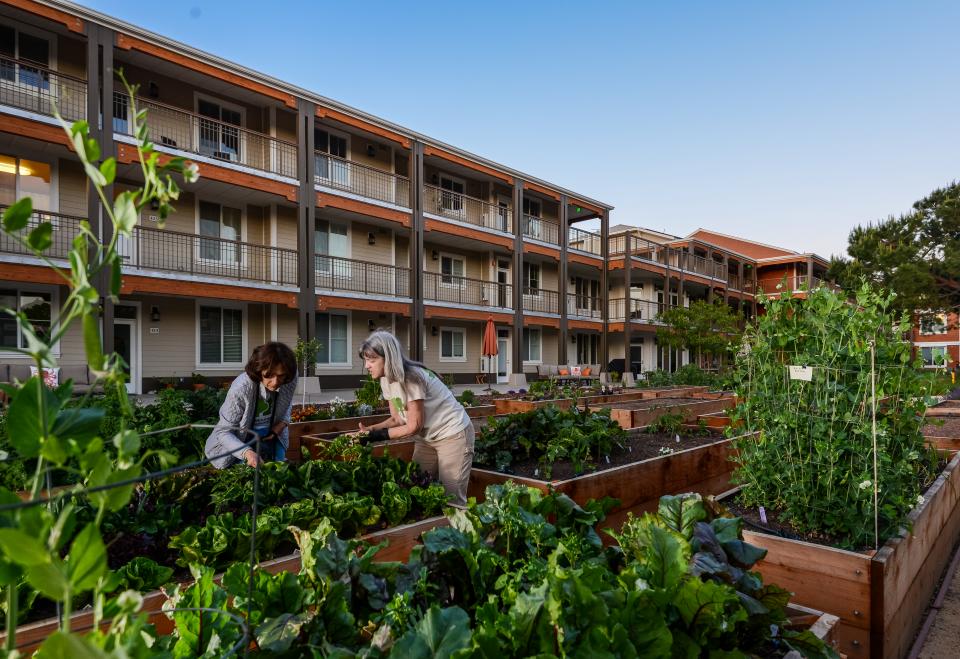
I received an email from the Mountain View Cohousing group about how they spent a couple of hours reconsidering the heating system, and telling me about what a profound, inspiring community building conversation that was. This group has grown into one of the most supportive communities. Neighbors jog with each other, garden alongside one another and enjoy each other’s conversation over a common meal. Cohousing is not that you have to do things for others, rather it allows you the opportunity to grow to do what you want for, and with, them.
Not “normal”, but smart
Our society isn’t conducive to making choices that contradict what is “normal.” Choosing cohousing isn’t normal, but it’s smart. And sometimes we have to make choices that are the best for us, even if they aren’t the easiest thing to do. That is what we tell our children, but we need to listen to the advice ourselves.
When I think about the amazing support the 20 seniors in our community receive, I realize that these were the few willing to look around and ask: What will really make my life easier? More convenient? More practical? More economical? More interesting? And more fun? I’m inclined to respond that it is the obvious ease of relationships, knowing that you’re not alone.
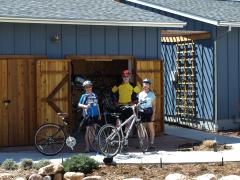
Seniors are increasingly valuing health and fun, and are choosing cohousing as a model that embraces this environment. I went to a concert in Nevada County a month ago, only to meet two cars full of senior cohousers from Wolf Creek Lodge Senior Cohousing who had carpooled to the event. Having neighbors that you can break bread with—community—is simply essential to your wellness. Currently, the myths that we live by – self-imposed restraints and fear of change keep many from considering cohousing and cohousing-inspired communities as an alternative to traditional housing models. These models, however, become more and more restrictive and isolating over time, and pretty soon, you’re left with no alternative but to move into a senior living where you have no say, no independence. And stale, manufactured community (if you can call it community).
If you’re lucky, you grow older. But having a good time as you age is no accident. You have to plan ahead—to “grab the fun” as my daughter Jessie would say—to enjoy what cohousing does for you. It’s going dinner with all of your friends; it’s having warm chicken soup brought to you when you’re sick; it’s having more help than you need for lifting something heavy; it’s enjoying plenty of space for your family to comfortably stay when they visit. Sometimes people annoy you, but you come to realize those are beautiful people, and you realize that they prepared this incredible dinner last night, or they drove to the concert and got you out the door. What’s in community living for you? Real life, and a lively life at that.
Thanks,
Charles Durrett
*Disclosure: The research and opinions in this article are those of the author, and may or may not reflect the official views of Tech-enhanced Life.
If you use the links on this website when you buy products we write about, we may earn commissions from qualifying purchases as an Amazon Associate or other affiliate program participant. This does not affect the price you pay. We use the (modest) income to help fund our research.
In some cases, when we evaluate products and services, we ask the vendor to loan us the products we review (so we don’t need to buy them). Beyond the above, Tech-enhanced Life has no financial interest in any products or services discussed here, and this article is not sponsored by the vendor or any third party. See How we Fund our Work.
